 Covering COVID-19 is a daily Poynter briefing of story ideas about the coronavirus and other timely topics for journalists, written by senior faculty Al Tompkins. Sign up here to have it delivered to your inbox every weekday morning.
Covering COVID-19 is a daily Poynter briefing of story ideas about the coronavirus and other timely topics for journalists, written by senior faculty Al Tompkins. Sign up here to have it delivered to your inbox every weekday morning.
What’s with these COVID-19 curfews? Do they make any scientific sense in controlling the virus? Just yesterday my son and I were talking about these very questions and Jane C. Hu popped up on Slate and answered them. Hu writes:
New York is not alone; in Massachusetts and two Colorado counties, 10 p.m. is also the bewitching hour. Things are a bit more lenient in Miami-Dade County, Florida, and in Virginia, where things close down at midnight. Internationally, Spain, Italy, and Moscow are also shutting down businesses earlier. But what, exactly, does a curfew accomplish? So far, there isn’t compelling evidence that curfews will necessarily slow the spread of COVID-19.
The logic seems to be that as the night wears on, people get increasingly more likely to do risky things like crowd into bars and not wear masks. But do curfews just push people to do their risky partying earlier, or out of sight? The Slate piece continues:
Early closures might actually encourage other risky behaviors. “Curfews often condense people visiting businesses into a narrower period of time, which often means more crowding and potential exposures,” says Saskia Popescu, an infectious disease epidemiologist at George Mason University.
William Hanage, an epidemiologist at the Harvard T. H. Chan School of Public Health, told USA Today that he doubts curfews do much to curb infections:
“Curtailing the evening for dining by an hour or so isn’t likely to make a very large impact,” Hanage said. “I can’t think of a single place where further action was not necessary.”
He concedes a curfew may cut down on alcohol-induced bad decisions, but he worries that people kicked out of bars and restaurants at 9:30 p.m. will congregate in small, airless apartments, where the risk of infection will be even higher.
Jennifer Weuve, an epidemiologist at the Boston University School of Public Health, told USA Today that curfews are a “blunt instrument” and that targeted actions like limiting indoor dining and cracking down on large indoor gatherings would matter a lot more.
Even if you do believe that it makes sense to impose curfews on bars, why are so many local governments also imposing the restrictions on gyms? Is there some rowdy behavior happening in gyms after 10 p.m.? It seems like it would be safest to work out then, when hardly anybody is around.
Connecticut is also forcing bowling alleys and movie theatres to close by 10 p.m. while Massachusetts added hair salons to its 9:30 p.m. curfew that also includes bars, gyms and theaters. Why?
All I am asking is for you journalists to ask questions when governments impose restrictions on businesses. Maybe we should listen to people who are angry that governments are overreaching on some things while being too timid on others. It seems to me you should be asking for some evidence that each restriction has a real scientific basis, such as those that exist for limiting crowds and wearing masks.
This spring, our local lockdown rule shut down self-service car washes. I am not aware of any evidence that people were catching the virus while washing their cars.
COVID-19 cases increase while interest in COVID-19 drops
Just look at these two charts from Axios and NewsWhip.
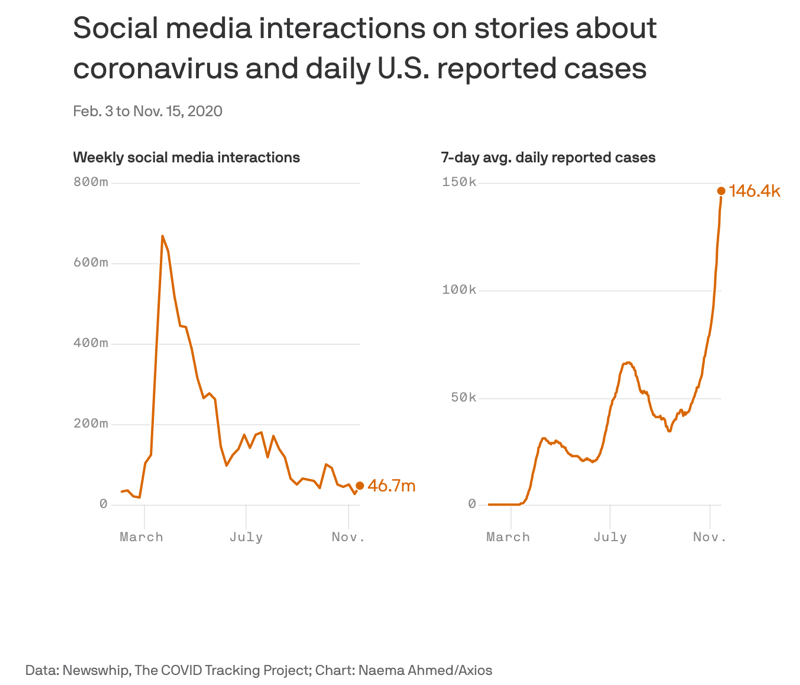
(Axios, NewsWhip)
On the left, you will see that social media interactions on posts about the coronavirus have hit an all-time low while, on the right, COVID-19 cases hit an all-time high. This is a critically important moment when the public should be engaged.
What’s going on? It could be that the public has tuned out news coverage that it considers to be alarmist. It could be that the coverage is the same bad news day after day.
My Poynter colleague Roy Peter Clark offers a dozen ways to make your pandemic coverage more interesting.
I glance at Google Trends every day while writing this column.

(Google Trends)
I look at see what people are searching for and then consider what I can offer that might help them in that search. On Tuesday, for example, people were really interested in how Dolly Parton had given money to the coronavirus vaccine testing that helped Moderna produce what appears to be a highly successful drug.
You will also notice that the issue of curfews, which I addressed in the item above this one, is a big trending topic. And I am surprised that more local news sites do not list where drive-thru testing is going on. The one thing that would be really useful is if there was a way to display wait times at those testing sites. Maybe you could try a live traffic-cam kind of display showing the line at the testing sites.
[the_ad id=”667826″]
Student loan relief is about to end. Payments will be due.
Unless Congress acts, student loan payments are due to start up again Jan. 1. Student loans are the fastest-growing category of personal debt in the U.S. next to mortgage loans.
President-elect Joe Biden affirmed this week that he still wants a student loan forgiveness bill. CNBC explains:
Biden had said he would forgive $10,000 in student debt for all borrowers, and the rest of the debt for those who attended public colleges or historically Black colleges and universities and earn less than $125,000 a year.
Biden’s student loan forgiveness plan, while it’s much narrower than the relief proposed by his opponents on the left in the Democratic primary, would still reset around 10 million borrowers’ balances to zero, according to calculations by higher education expert Mark Kantrowitz. In all, the policy would slash the country’s $1.7 trillion outstanding student loan tab by about a third.
It seems that this raises a basic question of fairness. What should we tell the people who didn’t go to schools they could not afford or the people who worked their behinds off to pay for college about why those who ran up student debt now should owe nothing? The Urban Institute argues that if debt forgiveness should be aimed at the populations who need the most financial help, there are better options.
Congress might also want to target loan relief to financially vulnerable borrowers. In that case, forgiving auto debt, medical debt, or payday loans would be more effective than forgiving student debt, which is held disproportionately by higher-income households. A recent analysis by the New York Fed found that people who have debt but no mortgage or student loan debt are concentrated in neighborhoods that are low-income, majority Black, or majority Hispanic.
It is difficult to justify picking student loans as the most problematic form of debt. Aside from being concentrated in the upper half of the income distribution, this debt represents borrowing for an investment that has, on average, a high expected payoff. Yet no one is suggesting paying off everyone’s mortgage debt — even though adequate housing is commonly viewed as a basic human right.
On the other hand, a recent study of 10,000 borrowers looked at what happens when people who owe student debt are freed from it. (In this one instance, a lender could not prove the debt that it claimed the people owed so a court tossed the debts out.) The study published by the National Bureau of Economic Research found “shock debt relief” led to borrowers becoming more mobile and moving to higher-paying jobs, and kept them from taking on more debt.
Some critics wonder if student debt was forgiven, even in a pandemic-fueled economic downturn, would it encourage the next wave of students to take out loans expecting their debt to be forgiven, too? Would forgiveness just encourage universities to do nothing to control the cost of higher education?
What is behind the high-flying housing market?
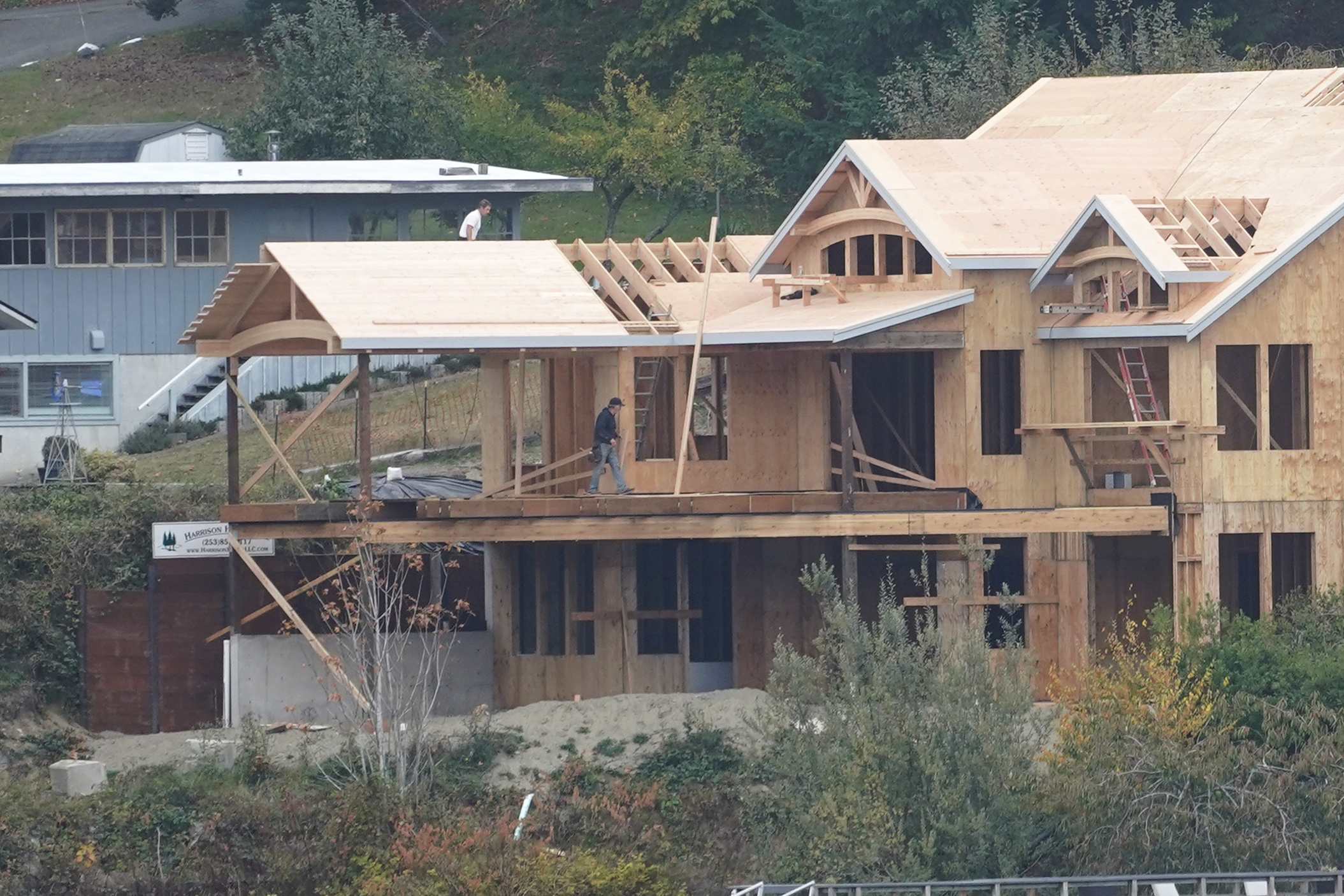
Workers are shown on a home under construction, Wednesday, Oct. 28, 2020, along the waterfront in Gig Harbor, Wash. (AP Photo/Ted S. Warren)
Today we will get new figures about housing starts. The figures should be impressive, based on new records recorded Tuesday.
The National Association of Home Builders Housing Market Index measures “builder confidence in the market for newly-built single-family homes.” That confidence level hit a new record this month, rivaled only by last month’s figure. In fact, this is the third month in a row that the index set records.
The index is based on three things: current sales, expected sales in the next six months and buyer traffic, which refers to how many people are looking for new homes. Generally, any score above 50 is seen as good news. This month, the score is 90.
Housing starts are important because they are a barometer for what people think the future holds. Housing and all of the stuff associated with it — including renovation and furnishing, buying and selling — amount to one-sixth of the U.S. economy.
Housing starts also forecast employment for people who build homes. New homes need appliances, fixtures and building permits, and they produce property taxes that are higher than taxes on vacant land. Generally, housing starts stall around this time of year, but this is 2020, and nothing is normal.
“It’s a reflection of consumer confidence,” says Sam Stovall, chief investment strategist for the research firm CFRA. “Who wants to engage in the biggest investment of their life — buying a house — if they’re worried about losing their job?”
In fact, Stovall looked at the historic data and found that every recession since 1960 has been preceded by a double-digit decline in housing starts.
“That’s why housing starts are so important,” he says.
One other piece of good news for homebuilders is that framing lumber prices have settled down.
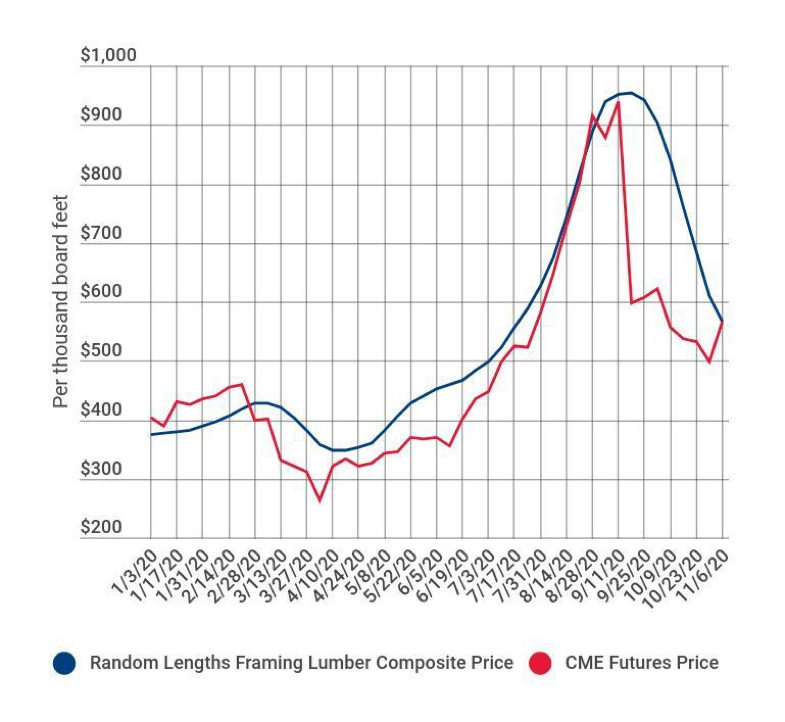
Framing lumber prices (National Association of Homebuilders)
Lumber prices are still higher than they were when the pandemic began, but are off their high prices from this spring, when lumber mills shut down because of the pandemic and people used their time at home to build stuff like decks.
Rent is falling in cities, rising in suburbs
Rent is falling in cities and rising in more suburban communities or midsize cities. The National Association of Home Builders reports:
Historically expensive markets such as San Francisco, San Jose, Seattle and Boston have seen double-digit decreases in asking rents since their March peak. Meanwhile, smaller suburbs and cities such as Inland Empire, Calif. (a bedroom community of Los Angeles), Norfolk and Richmond, Va., and Memphis, Tenn., have seen rents increase between 3.6% to 5.3%.
Not every suburb is the same, though, noted Charles Elliott, president of Toll Brothers Apartment Living — both in terms of performance as well as mindset.
“The meaning of suburbs is very relative to people,” he stated, providing Toll Brothers’ success in the urban core of New Jersey — which can be considered a suburb of New York City — as an example.
Elliott predicts the urban and walkable suburban markets will come back strong because of rising interest among Gen Z, and also noted increased interest in second homes as a result of the increased flexibility of working from home.
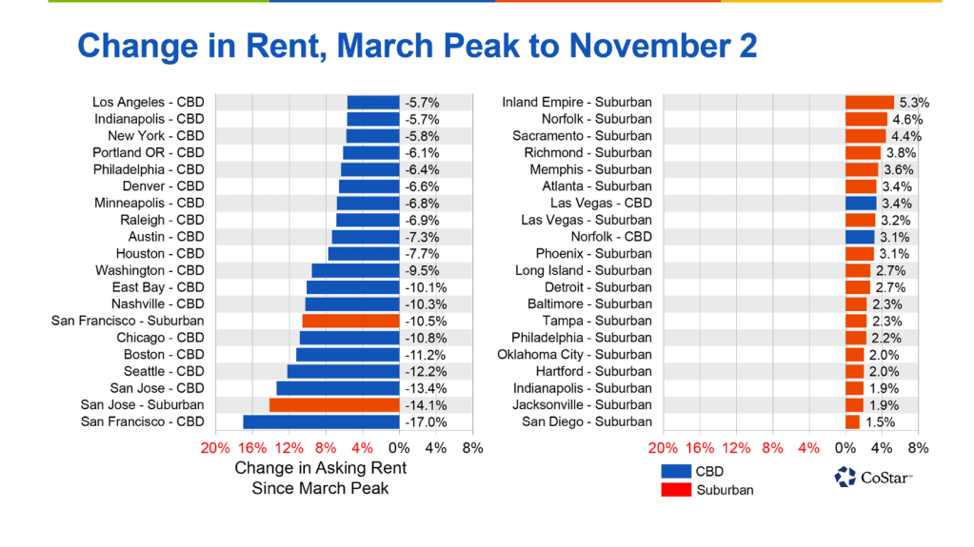
Home rent trends comparing Central Business Districts with suburban homes (National Association of Homebuilders)
Homeless shelters are under pressure
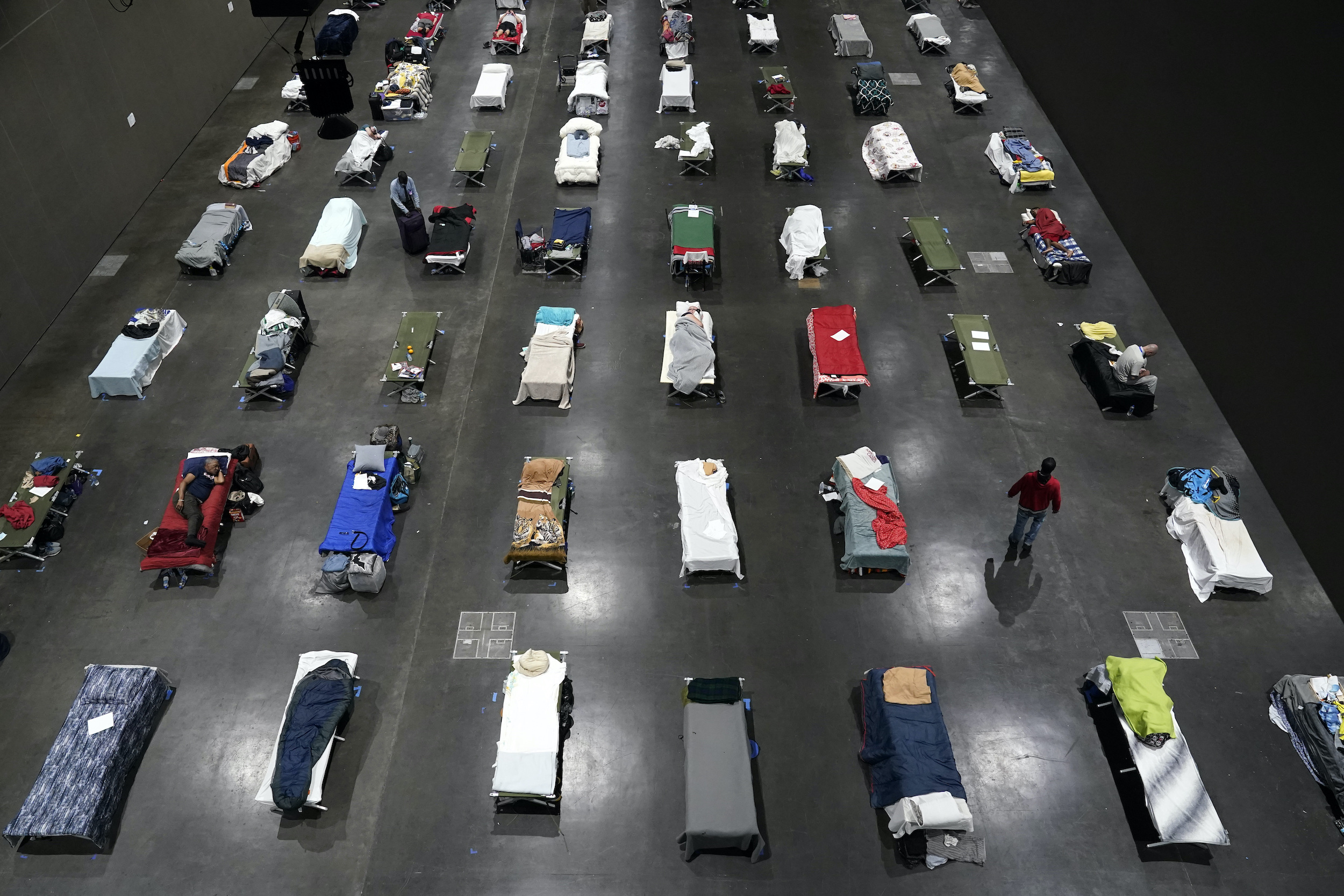
Beds fill a homeless shelter inside the San Diego Convention Center Tuesday, Aug. 11, 2020, in San Diego. (AP Photo/Gregory Bull)
Kaiser Health News reminds us that without a new federal stimulus package or any extension of a ban against evictions, we could see a flood of wintertime evictions that put more people on the street.
“The homeless check off most boxes in terms of being the most susceptible and most vulnerable to the COVID-19 pandemic, and most likely to spread and most likely to die from it,” said Neli Vazquez Rowland, founder of A Safe Haven Foundation, a Chicago nonprofit that has been operating a “medical respite” isolation facility for homeless individuals with the coronavirus.
Demand for shelter could grow. Stimulus checks helped stave off some of the pandemic’s initial economic pain, but Congress has stalled on additional relief packages. And though the Trump administration has ordered a moratorium on evictions for tenants who meet certain conditions through the end of the year, a group of landlords is suing to stop the ban. Some states have their own prohibitions on evictions, but only Illinois, Minnesota and Kansas do in the Midwest.
I am seeing stories about the increase in homeless populations across the country — in Salt Lake City and Minneapolis, for example.
There is already clinical evidence that “communal” sleeping quarters, like you would find in most homeless shelters, is linked to a higher incidence of COVID-19.
Los Angeles is considering how it might use its currently unused convention center as a homeless shelter. The Los Angeles Times reports:
Mayor Eric Garcetti said he was open to the idea of using the convention center as a shelter but didn’t want anything to come at the expense of using hotel and motel rooms, which he said have been a more effective way to move people off the street.
Cities nationwide are trying to find ways to house people who are without homes this winter because traditional shelters cannot host as many people as usual during the pandemic.
[the_ad id=”667872″]
Food banks need volunteers
The Chicago Sun-Times says the spreading pandemic is making it harder for food banks to recruit volunteers while increasing the number of people who need help.
Thousands of families lined up in Dallas on Saturday for a giveaway hosted by the North Texas Food Bank, and the organization called it its largest ever. https://t.co/5B3tXMXLn6
— CBSDFW (@CBSDFW) November 15, 2020
Quilt coats
Leave it to 2020 to make quilts controversial. The New York Times produced a quirky story on how people want to be shrouded by a comfy quilt all the time, so they are turning quilts into jackets. Some people are complaining that you should not be cutting up heirlooms to take part in a trendy fashion thing.
There are already companies that sell these things. One Austin company, Psychic Outlaw, posts quilts every Thursday that it will turn into coats. They sell out in minutes.
All of this reminds me of an old Dolly Parton tune, “Coat of Many Colors.” A fun little fact: She was traveling on a tour bus with Porter Wagoner when the song popped in her head. She could not find anything to write on, so she composed the lyrics on a dry-cleaning receipt for one of Wagoner’s colorful suits. The song concludes:
But they didn’t understand it, and I tried to make them see
One is only poor, only if they choose to be
Now I know we had no money, but I was rich as I could be
In my coat of many colors my momma made for me
This is the first time I have included Dolly Parton’s name twice in one day’s column. Did I mention she has a new album? That’s three Dollys in one day. And if I can find an excuse to do that more often, I will. She’s good medicine for what ails us.
[the_ad id=”667878″]
We’ll be back tomorrow with a new edition of Covering COVID-19. Sign up here to get it delivered right to your inbox.







